Land Suitability Evaluation and an Interval Stochastic Fuzzy Programming-Based Optimization Model for Land-Use Planning and Environmental Policy Analysis
Abstract
1. Introduction
2. The Study Area
3. Land Suitability Evaluation
3.1. GIS-Based Land Suitability Evaluation Model
3.2. Suitability Evaluation Factors
3.3. Factor Weighting and Overlap Analysis
4. Interval Stochastic Fuzzy Programming and Land Suitability Evaluation Based Land-Use Allocation Model
4.1. Objective Function
4.2. Economic Constraints
4.3. Social Constraints
4.4. Land Suitability Constraint
4.5. Environmental Constraints
4.6. Ecological Constraints
4.7. Technical Constraints
4.8. Parameters
4.9. Model Solving
5. Result Analysis
5.1. Optimized Land-Use Patterns
5.2. Relationship between Land Suitability Level and System Benefit
5.3. Tradeoff between Economic Development and Environment Capacity
5.4. Fuzzy Relationship between Objective and Constraints
6. Discussion
7. Conclusions
Author Contributions
Funding
Conflicts of Interest
References
- Jeroen, A.; Marjan, V.H.; Ron, J.; Theodor, S. Evaluating Spatial Design Techniques for Solving Land-use Allocation Problems. J. Environ. Plan. Manag. 2005, 48, 121–142. [Google Scholar]
- Arciniegas, G.; Janssen, R.; Omtzigt, N. Map-based multicriteria analysis to support interactive land use allocation. Int. J. Geogr. Inf. Sci. 2011, 25, 1931–1947. [Google Scholar] [CrossRef]
- Chakir, R.; Le Gallo, J. Predicting land use allocation in France: A spatial panel data analysis. Ecol. Econ. 2013, 92, 114–125. [Google Scholar] [CrossRef]
- Chu, H.J.; Lin, Y.P.; Huang, C.W.; Hsu, C.Y.; Chen, H.Y. Modelling the hydrologic effects of dynamic land-use change using a distributed hydrologic model and a spatial land-use allocation model. Hydrol. Process. 2010, 24, 2538–2554. [Google Scholar] [CrossRef]
- Cromley, R.G.; Hanink, D.M. Coupling land use allocation models with raster GIS. J. Geogr. Syst. 1999, 1, 137–153. [Google Scholar] [CrossRef]
- Eldrandaly, K. A GEP-based spatial decision support system for multisite land use allocation. Appl. Soft Comput. 2010, 10, 694–702. [Google Scholar] [CrossRef]
- Jenerette, G.D.; Wu, J. Analysis and simulation of land-use change in the central Arizona–Phoenix region, USA. Landsc. Ecol. 2001, 16, 611–626. [Google Scholar] [CrossRef]
- Parra Paitan, C.; Verburg, P.H. Methods to assess the impacts and indirect land use change caused by telecoupled agricultural supply chains: A review. Sustainability 2019, 11, 1162. [Google Scholar] [CrossRef]
- Liang, J.; Zhong, M.; Zeng, G.; Chen, G.; Hua, S.; Li, X.; Yuan, Y.; Wu, H.; Gao, X. Risk management for optimal land use planning integrating ecosystem services values: A case study in Changsha, Middle China. Sci. Total Environ. 2017, 579, 1675–1682. [Google Scholar] [CrossRef]
- Ligmann-Zielinska, A.; Church, R.L.; Jankowski, P. Spatial optimization as a generative technique for sustainable multiobjective land-use allocation. Int. J. Geogr. Inf. Sci. 2008, 22, 601–622. [Google Scholar] [CrossRef]
- Santé-Riveira, I.; Boullón-Magán, M.; Crecente-Maseda, R.; Miranda-Barrós, D. Algorithm based on simulated annealing for land-use allocation. Comput. Geosci. 2008, 34, 259–268. [Google Scholar] [CrossRef]
- Verburg, P.H.; Koning, G.H.J.D.; Kok, K.; Veldkamp, A.; Bouma, J. A spatial explicit allocation procedure for modelling the pattern of land use change based upon actual land use. Ecol. Model. 1999, 116, 45–61. [Google Scholar] [CrossRef]
- Verburg, P.H.; Soepboer, W.; Veldkamp, A.; Limpiada, R.; Espaldon, V.; Mastura, S.S. Modeling the spatial dynamics of regional land use: The CLUE-S model. Environ. Manag. 2002, 30, 391–405. [Google Scholar] [CrossRef] [PubMed]
- Zhang, H.; Zeng, Y.; Jin, X.; Shu, B.; Zhou, Y.; Yang, X. Simulating multi-objective land use optimization allocation using Multi-agent system—A case study in Changsha, China. Ecol. Model. 2016, 320, 334–347. [Google Scholar] [CrossRef]
- Aerts, J.C.J.H.; Eisinger, E.; Heuvelink, G.B.M.; Stewart, T.J. Using Linear Integer Programming for Multi-Site Land-Use Allocation. Geogr. Anal. 2003, 35, 148–169. [Google Scholar] [CrossRef]
- Diamond, J.T.; Wright, J.R. Efficient Land Allocation. J. Urban Plan. Dev. 1989, 115, 81–96. [Google Scholar] [CrossRef]
- Lu, S.; Zhou, M.; Guan, X.; Tao, L. An integrated GIS-based interval-probabilistic programming model for land-use planning management under uncertainty-a case study at Suzhou, China. Environ. Sci. Pollut. Res. 2015, 22, 4281–4296. [Google Scholar] [CrossRef]
- Ma, C.; Zhou, M. A GIS-Based Interval Fuzzy Linear Programming for Optimal Land Resource Allocation at a City Scale. Soc. Indic. Res. 2016, 135, 143–166. [Google Scholar] [CrossRef]
- Mendoza, G.A. A mathematical model for generating land-use allocation alternatives for agroforestry systems. Agrofor. Syst. 1987, 5, 443–453. [Google Scholar] [CrossRef]
- Ou, G.; Tan, S.; Zhou, M.; Lu, S.; Tao, Y.; Zhang, Z.; Zhang, L.; Yan, D.; Guan, X.; Wu, G. An interval chance-constrained fuzzy modeling approach for supporting land-use planning and eco-environment planning at a watershed level. J. Environ. Manag. 2017, 204 Pt 1, 651–666. [Google Scholar] [CrossRef]
- Zhou, M.; Cai, Y.; Guan, X.; Tan, S.; Lu, S. A Hybrid Inexact Optimization Model for Land-use Allocation of China. Chin. Geogr. Sci. 2015, 25, 62–73. [Google Scholar] [CrossRef]
- Zhou, M.; Tan, S.; Tao, L.; Zhu, X.; Akhmat, G. An interval fuzzy land-use allocation model (IFLAM) for Beijing in association with environmental and ecological consideration under uncertainty. Qual. Quant. 2015, 49, 2269–2290. [Google Scholar] [CrossRef]
- Brath, A.; Montanari, A.; Moretti, G. Assessing the effect on flood frequency of land use change via hydrological simulation (with uncertainty). J. Hydrol. 2006, 324, 141–153. [Google Scholar] [CrossRef]
- Brown, D.G.; Goovaerts, P. Stochastic Simulation of Land-Cover Change Using Geostatistics and Generalized Additive Models. Photogramm. Eng. Remote Sens. 2002, 68, 1051–1062. [Google Scholar]
- Gao, X.; Luo, Y.; Lin, W.; Zhao, Z.; Giorgi, F. Simulation of effects of land use change on climate in China by a regional climate model. Adv. Atmos. Sci. 2003, 20, 583–592. [Google Scholar]
- Ito, A.; Oikawa, T. A simulation model of the carbon cycle in land ecosystems (Sim-CYCLE): A description based on dry-matter production theory and plot-scale validation. Ecol. Model. 2002, 151, 143–176. [Google Scholar] [CrossRef]
- Kamusoko, C.; Aniya, M.; Adi, B.; Manjoro, M. Rural sustainability under threat in Zimbabwe-simulation of future land use/cover changes in the Bindura district based on the Markov-cellular automata model. Appl. Geogr. 2009, 29, 435–447. [Google Scholar] [CrossRef]
- Polhill, J.G.; Gotts, N.M.; Law, A.N.R. Imitative versus nonimitative strategies in a land-use simulation. Cybern. Syst. 2001, 32, 285–307. [Google Scholar]
- Stéphenne, N.; Lambin, E.F. A dynamic simulation model of land-use changes in Sudano-sahelian countries of Africa (SALU). Agric. Ecosyst. Environ. 2001, 85, 145–161. [Google Scholar] [CrossRef]
- Tang, W. FUTURES: Multilevel Simulations of Emerging Urban–Rural Landscape Structure Using a Stochastic Patch-Growing Algorithm. Ann. Assoc. Am. Geogr. 2013, 103, 785–807. [Google Scholar]
- Wu, F. A linguistic cellular automata simulation approach for sustainable land development in a fast growing region. Comput. Environ. Urban Syst. 1996, 20, 367–387. [Google Scholar] [CrossRef]
- Parker, D.C.; Manson, S.M.; Janssen, M.A.; Hoffmann, M.J.; Deadman, P. Multi-Agent Systems for the Simulation of Land-Use and Land-Cover Change: A Review. Ann. Assoc. Am. Geogr. 2015, 93, 314–337. [Google Scholar] [CrossRef]
- Braithwaite, W.; Belbin, L.; Ive, J.; Austin, M. Land use allocation and biological conservation in the Batemans Bay Forests of New South Wales. Aust. For. 1993, 56, 4–21. [Google Scholar] [CrossRef]
- Liu, X.; Li, X.; Shi, X.; Huang, K.; Liu, Y. A multi-type ant colony optimization MACO method for optimal land use allocation in large areas. Int. J. Geogr. Inf. Sci. 2012, 26, 1325–1343. [Google Scholar] [CrossRef]
- Riveiro, J.A.; Alvarez, C.J.; Pereira, J.M.; Miranda, D. Profitability and production requirements for land use allocation of farming and forestry land. Biosyst. Eng. 2005, 90, 477–484. [Google Scholar] [CrossRef]
- Tang, W.; Bennett, D.A.; Wang, S. A parallel agent-based model of land use opinions. J. Land Use Sci. 2011, 6, 121–135. [Google Scholar] [CrossRef]
- Tang, W.; Bennett, D.A. In Parallel Agent-Based Modelling of Land-Use Opinion Dynamics Using Graphics Processing Units. In Proceedings of the 10th International Conference on GeoComputation, Sydney, Australia, 16–19 November 2009. [Google Scholar]
- Verburg, P.H.; Eickhout, B.; Meijl, H.V. A multi-scale, multi-model approach for analyzing the future dynamics of European land use. Ann. Reg. Sci. 2008, 42, 57–77. [Google Scholar] [CrossRef]
- Wang, S.H.; Huang, S.L.; Budd, W.W. Integrated ecosystem model for simulating land use allocation. Ecol. Model. 2012, 227, 46–55. [Google Scholar] [CrossRef]
- Liu, X.; Ou, J.; Li, X.; Ai, B. Combining system dynamics and hybrid particle swarm optimization for land use allocation. Ecol. Model. 2013, 257, 11–24. [Google Scholar] [CrossRef]
- Liu, Y.; Cai, Y.P.; Huang, G.H.; Dong, C. Interval-parameter chance-constrained fuzzy multi-objective programming for water pollution control with sustainable wetland management. Procedia Environ. Sci. 2012, 13, 2316–2335. [Google Scholar] [CrossRef]
- Dempsey, J.A.; Plantinga, A.J.; Kline, J.D.; Lawler, J.J.; Martinuzzi, S.; Radeloff, V.C.; Bigelow, D.P. Effects of local land-use planning on development and disturbance in riparian areas. Land Use Policy 2017, 60, 16–25. [Google Scholar] [CrossRef]
- Li, Y.P.; Huang, G.H.; Nie, S.L. An interval-parameter multi-stage stochastic programming model for water resources management under uncertainty. Adv. Water Resour. 2006, 29, 776–789. [Google Scholar] [CrossRef]
- Wilby, R.L. Uncertainty in water resource model parameters used for climate change impact assessment. Hydrol. Process. 2010, 19, 3201–3219. [Google Scholar] [CrossRef]
- Nuttle, T.; Bredeweg, B.; Salles, P.; Neumann, M. Simulating an uncertain world: Using qualitative reasoning to model a plant-resource system. In Proceedings of the 2008 Iemss Fourth Biennial Meeting: International Congress on Environmental Modelling and Software, Barcelona, Spain, 14–16 December 2008; pp. 2001–2002. [Google Scholar]
- Cai, Y.P.; Huang, G.H.; Lin, Q.G.; Nie, X.H.; Tan, Q. An optimization-model-based interactive decision support system for regional energy management systems planning under uncertainty. Expert Syst. Appl. 2009, 36, 3470–3482. [Google Scholar] [CrossRef]
- Tan, Z.F.; Ju, L.W.; Li, H.H.; Li, J.Y.; Zhang, H.J. A two-stage scheduling optimization model and solution algorithm for wind power and energy storage system considering uncertainty and demand response. Int. J. Electr. Power Energy Syst. 2014, 63, 1057–1069. [Google Scholar] [CrossRef]
- Jiang, X.U.; Yeh, A.G.O.; Jiang, X.U. Regional Cooperation in the Pan-Pearl River Delta: A Formulaic Aspiration or A New Imagination? Built Environ. 2008, 34, 408–426. [Google Scholar]
- FAO. A Frame Work for Land Evaluation; FAO: Rome, Italy, 1976. [Google Scholar]
- Wang, X.; Yu, S.; Huang, G.H. Land allocation based on integrated GIS-optimization modeling at a watershed level. Landsc. Urban Plan. 2004, 66, 61–74. [Google Scholar] [CrossRef]
- Dai, F.C.; Lee, C.F.; Zhang, X.H. GIS-based geo-environmental evaluation for urban land-use planning: A case study. Eng. Geol. 2001, 61, 257–271. [Google Scholar] [CrossRef]
- Zhang, X.; Fang, C.; Wang, Z.; Haitao, M.A. Urban Construction Land Suitability Evaluation Based on Improved Multi-criteria Evaluation Based on GIS(MCE-GIS): Case of New Hefei City, China. Chin. Geogr. Sci. 2013, 23, 740–753. [Google Scholar] [CrossRef]
- McKenna, H.P. The Delphi technique: A worthwhile research approach for nursing? J. Adv. Nurs. 1994, 19, 1221–1225. [Google Scholar] [CrossRef]
- Zhou, M. An interval fuzzy chance-constrained programming model for sustainable urban land-use planning and land use policy analysis. Land Use Policy 2015, 42, 479–491. [Google Scholar] [CrossRef]
- Dalla-Nora, E.L.; Aguiar, A.P.D.D.; Lapola, D.M.; Woltjer, G. Why have land use change models for the Amazon failed to capture the amount of deforestation over the last decade? Land Use Policy 2014, 39, 403–411. [Google Scholar] [CrossRef]
- Karrasch, L.; Klenke, T.; Woltjer, J. Linking the ecosystem services approach to social preferences and needs in integrated coastal land use management–A planning approach. Land Use Policy 2014, 38, 522–532. [Google Scholar] [CrossRef]
- Kanianska, R.; Kizekova, M.; Novacek, J.; Zeman, M. Land-use and land-cover changes in rural areas during different political systems: A case study of Slovakia from 1782 to 2006. Land Use Policy 2014, 36, 554–566. [Google Scholar] [CrossRef]

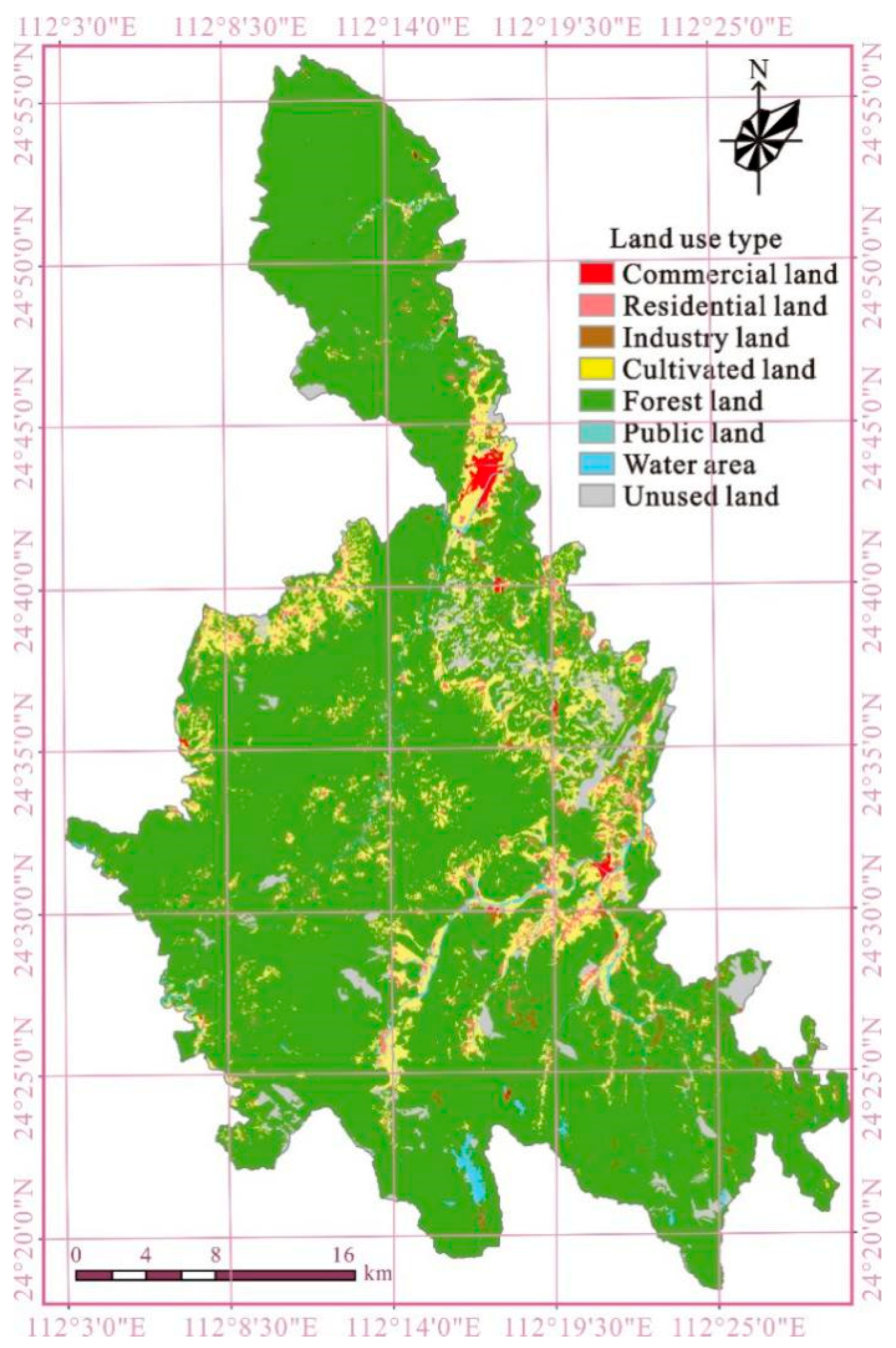
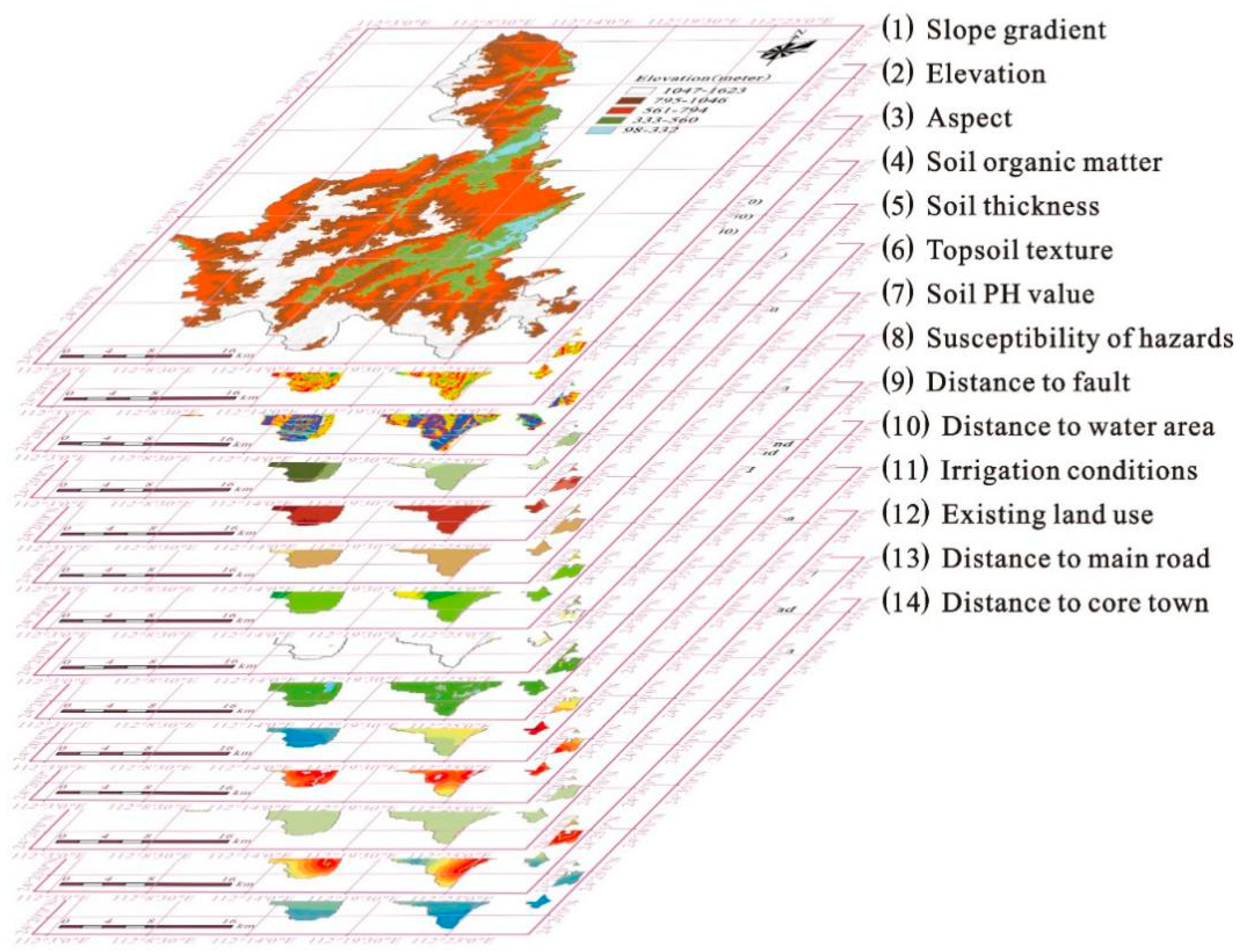
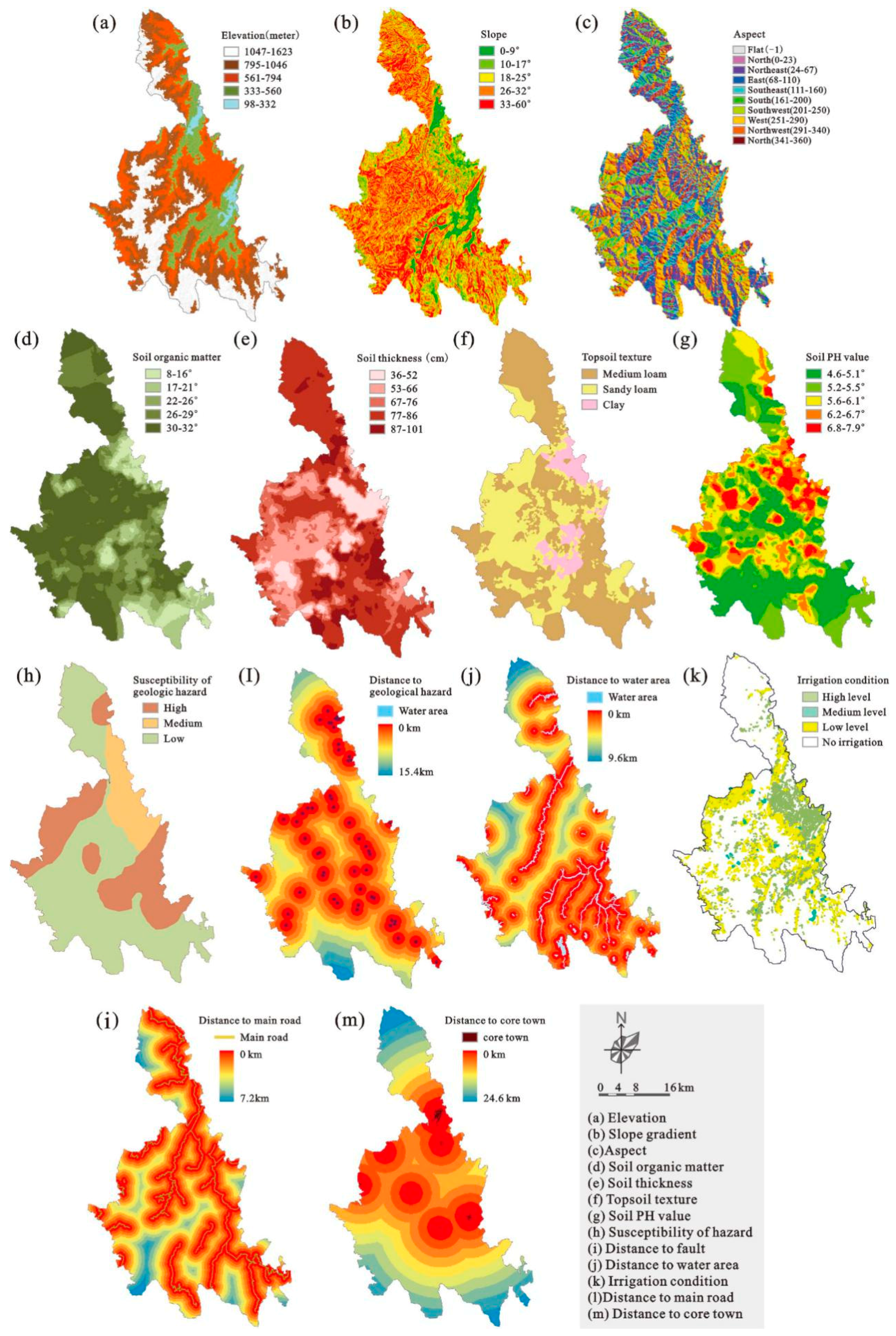
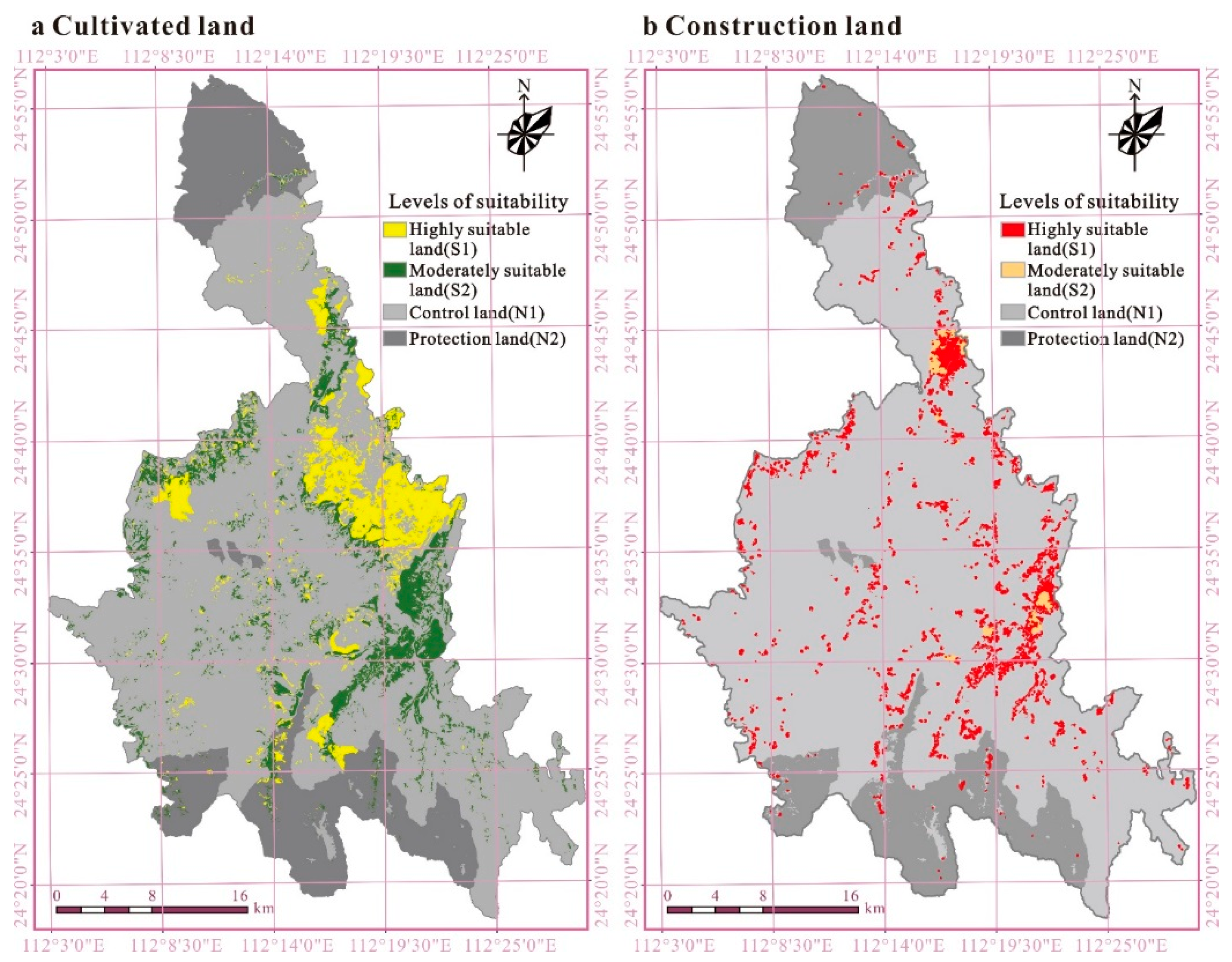
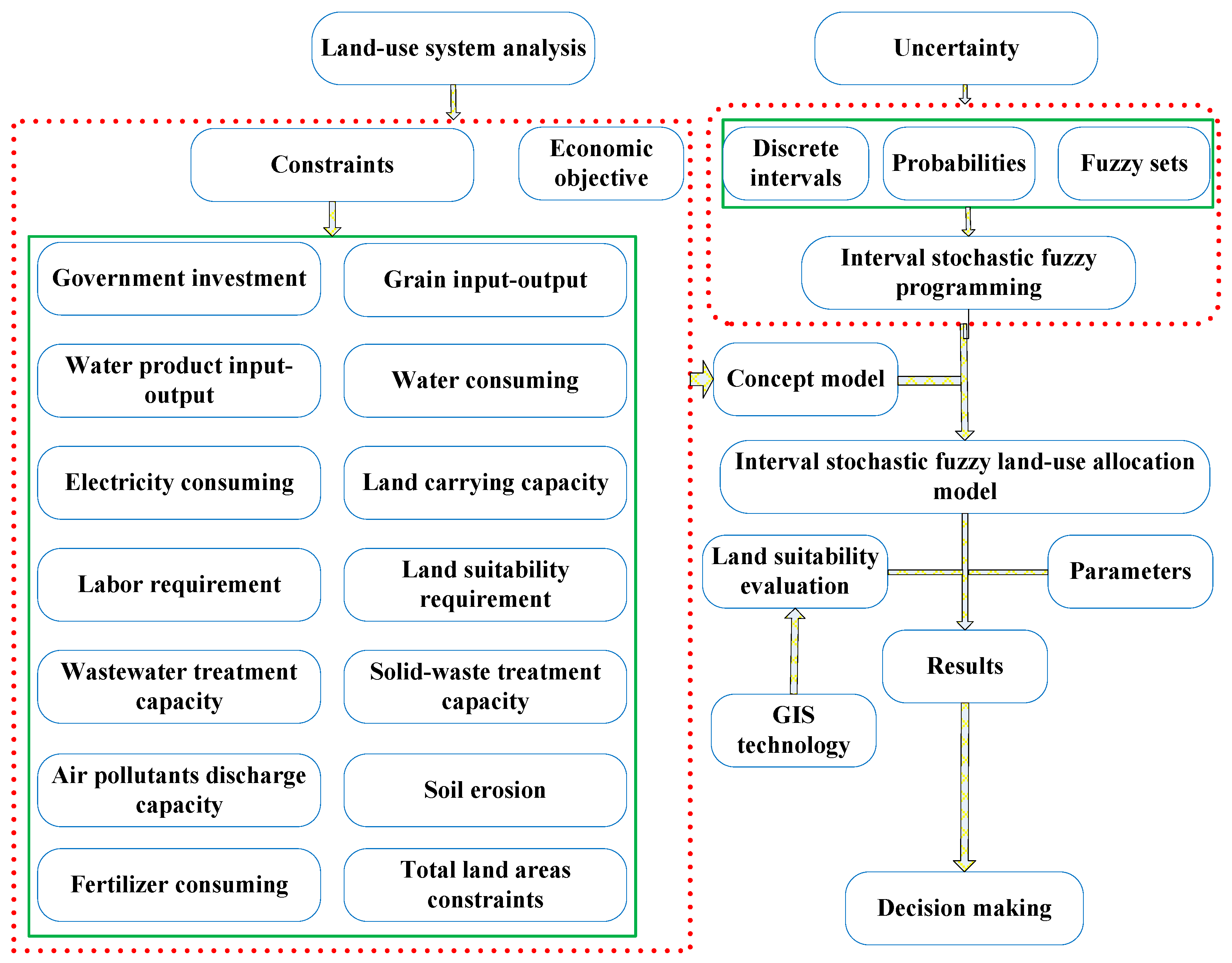
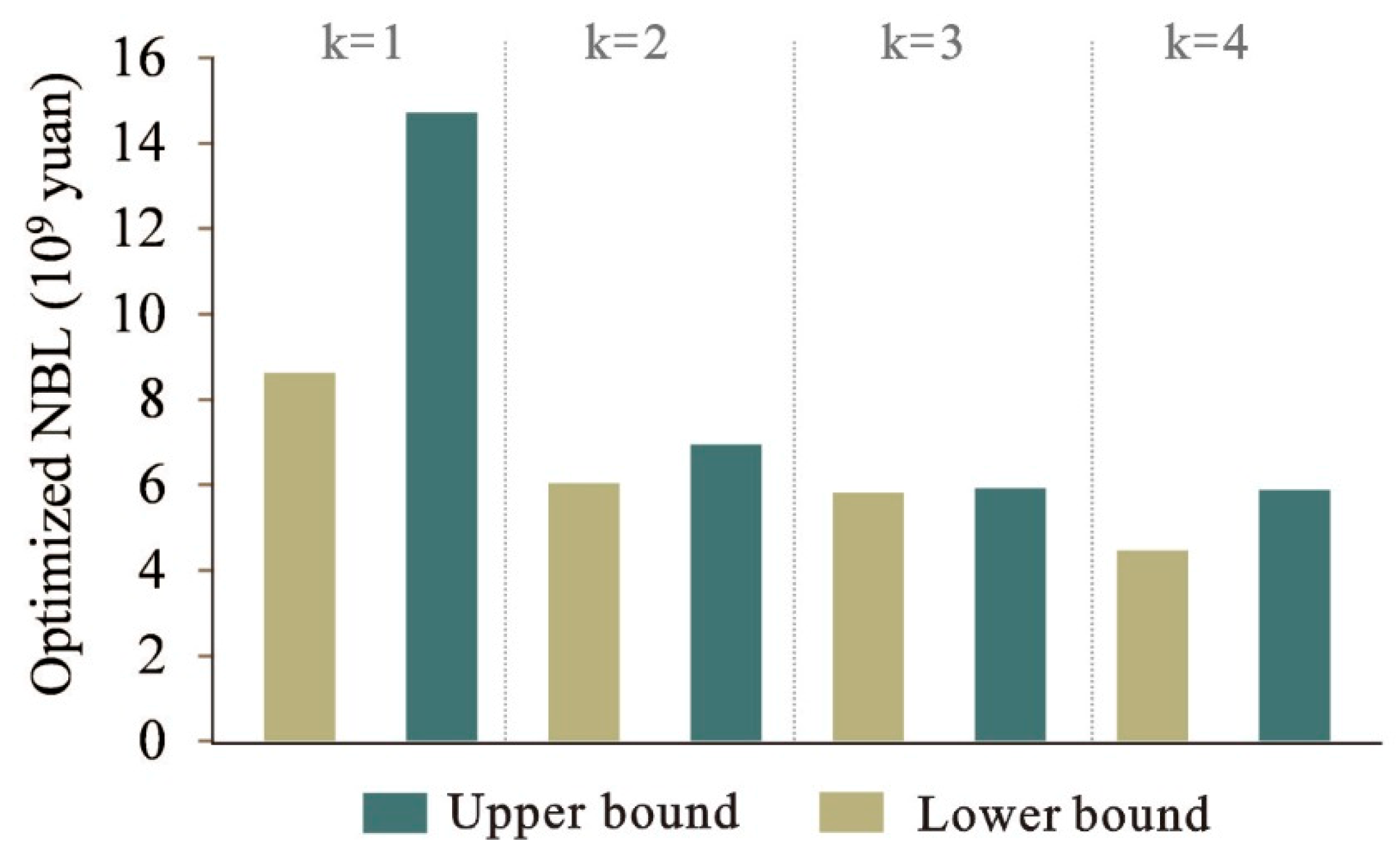
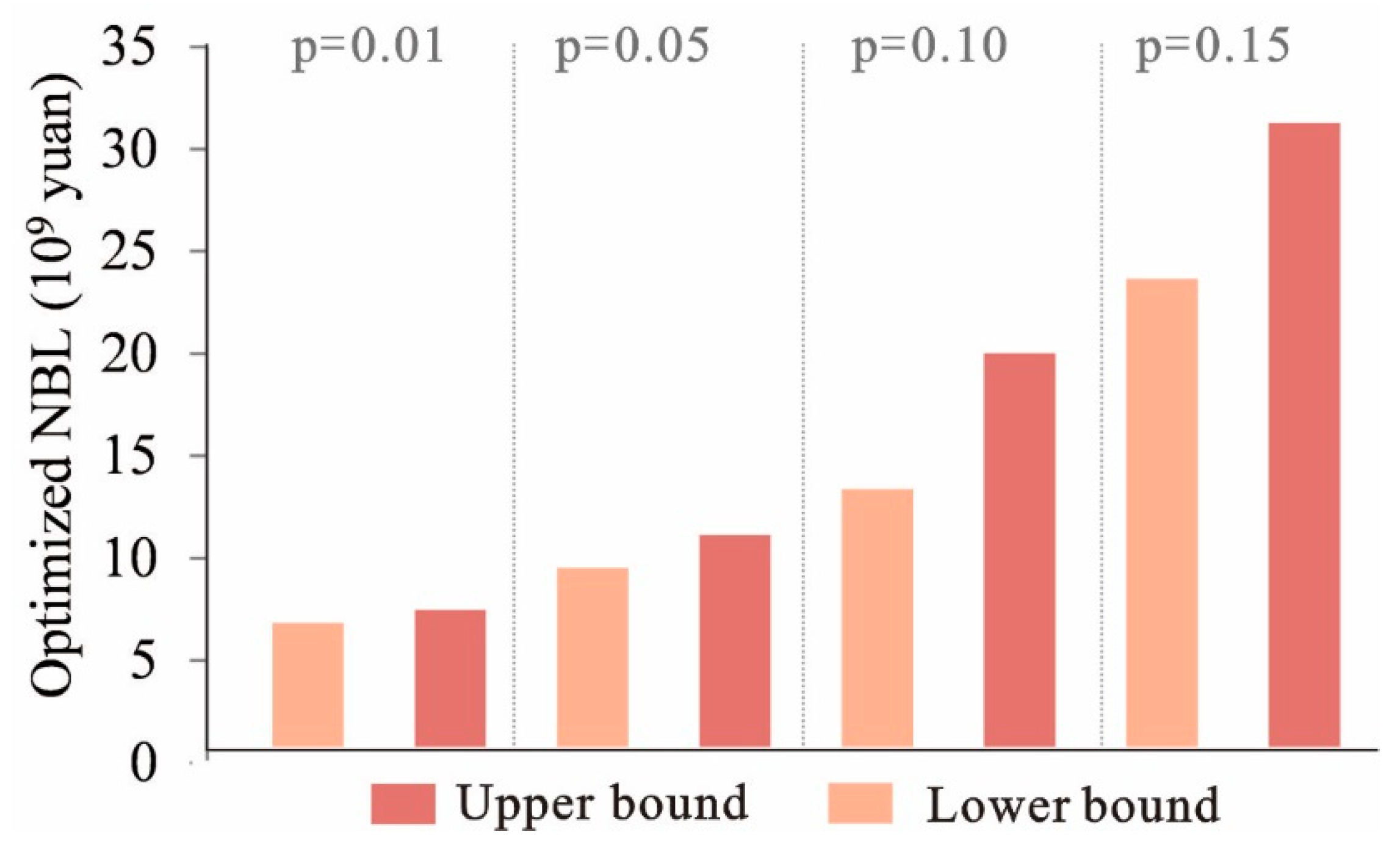
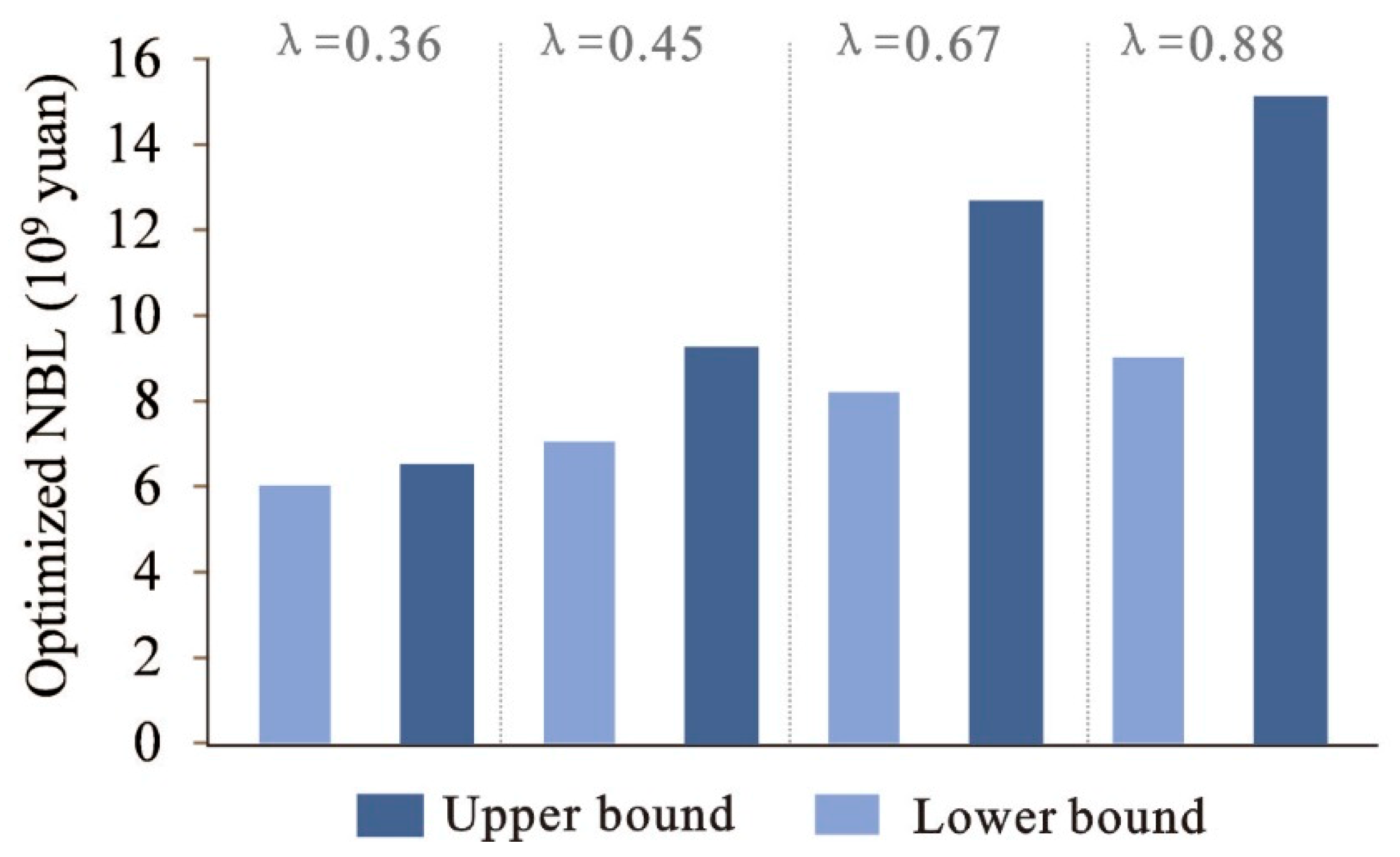
| Physical Characteristics | Suitability Rating Score | S1 100–90 | S2 90–80 | S3 80–60 | N1 60–30 | N2 30 |
|---|---|---|---|---|---|---|
| Cultivated land | ||||||
| Topography | Slope gradient (°) (0.5) | <1.0 (100) | 1.0–2.0 (90) | 2.0–5.0 (80) | 5.0–15.0 (40) | >15.0 (0) |
| Elevation (meter) (0.3) | <30 (90) | 30–50 (80) | 50–100 (70) | 100–200 (50) | >200 (10) | |
| Aspect (0.2) | Flat (100) | 135–225 (90) | 90–135,225–270 (80) | 45–90, 270–315 (60) | 0–45, 315–360 (50) | |
| Ground conditions | Soil organic matter (%) (0.3) | >3.0 (100) | 2.0–3.0 (90) | 1.0–2.0 (80) | 0.6–1.0 (60) | <0.6 (50) |
| Soil thickness (centimeter) (0.3) | >100 (100) | 60–100 (90) | - | 30–60 (60) | <30 (30) | |
| Topsoil texture (0.2) | Medium loam (100) | Heavy/light loam (90) | Sandy loam (80) | Clay (60) | - | |
| Soil PH value (0.2) | 6.0–7.9 (100) | 5.5–6.0 (90) | 5.0–5.5,7.9–8.5 (60) | 4.5–5.0(50) | <4.5, >8.5 (30) | |
| Geological hazards | Susceptibility of hazards (0.5) | Low (100) | Medium (90) | - | High (60) | - |
| Distance to fault (meter) (0.5) | >300 (100) | 100–300 (90) | 50–100 (60) | 30–50 (30) | <30 (10) | |
| Hydrology conditions | Distance to water area (kilometer) (0.5) | 0–0.5 (100) | 0.5–1.0 (90) | 1.0–2.0 (60) | 2.0–5.0 (50) | >5.0 (30) |
| Irrigation conditions (0.5) | High (100) | Medium (90) | Low (60) | No (30) | - | |
| Commercial land, residential land, and industrial land | ||||||
| Topography | Slope gradient (°) (0.5) | <1.0 (100) | 1.0–2.0 (90) | 2.0–5.0 (80) | 5.0–15.0 (40) | >15.0 (0) |
| Elevation (meter) (0.3) | <30 (90) | 30–50 (80) | 50–100 (70) | 100–200 (50) | >200 (10) | |
| Aspect (0.2) | Flat | 135–225 | 90–135, 225–270 | 45–90, 270–315 | 0–45, 315–360 | |
| Ground conditions | Existing land-use (0.6) | Construction land (100) | Cultivated land (90) | - | Forest land (40) | Water area (30) |
| Topsoil texture (0.4) | Medium loam (100) | Heavy/light loam (90) | Sandy loam (80) | Clay (60) | - | |
| Geological hazards | Susceptibility of hazards (0.5) | Low (100) | Medium (90) | - | High (60) | - |
| Distance to fault (meter) (0.5) | >300 (100) | 100–300 (90) | 50–100 (60) | 30–50 (30) | <30 (10) | |
| Spatial location | Distance to main roads (meter) (0.5) | <100 (95) | 100–300 (85) | 300–800 (70) | 800–1500 (40) | >1500 (10) |
| Distance to core towns (0.5) | 0–1.0 (100) | 1.0–2.0 (90) | 2.0–5.0 (60) | 5.0–10.0(50) | >10.0 (30) | |
| Symbol | Meaning | Symbol | Meaning |
|---|---|---|---|
| NBL | Objective function, which means the net benefit from land-use system | UWTC | Unit wastewater-tackling cost of land-use types j = 1–7 |
| Discrete interval values | USTC | Unit solid waste-tackling cost of land-use types j = 1–7 | |
| Fuzzy equal | UMC | Unit maintenance cost of landfill | |
| x | Independent variables, which means the land areas of each land use | UDC | Unit developing costs of unused land. |
| b | Unit benefit of land use types j = 1–7 | UESC | Unit electric power-supply cost of land-use types j = 1–7 |
| j | Type of land use, where j = 1 for cultivate land, j = 2 for garden land, j = 3 for forest land, j = 4 for grassland, j = 5 for construction land, j = 6 for transportation land, j = 7 for water land, j = 8 for landfill, and j = 9 for unused land | UGTC | Unit waste-gas-tackling cost of land use types j = 1–7; UWSC = unit water-supply cost of land use types j = 1–7 |
| k | Land suitability condition, where k = 1 for highly suitable (S1); k = 2 for moderately suitable (S2); k = 3 for control suitable (N1); k = 4 for non-suitable (N2) |
| Benefit Parameters | Unit | k = 1 | k = 2 | k = 3 | k = 4 | ||||
|---|---|---|---|---|---|---|---|---|---|
| Lower Bound | Upper Bound | Lower Bound | Upper Bound | Lower Bound | Upper Bound | Lower Bound | Upper Bound | ||
| bj=1 | 106 | 2.35 | 5.04 | 1.95 | 4.28 | 1.64 | 4.01 | 1.24 | 3.32 |
| bj=2 | 103 | 3.51 | 5.64 | 3.25 | 5.01 | 2.89 | 4.49 | 2.19 | 3.67 |
| bj=3 | 103 | 1.25 | 2.04 | 1.12 | 1.98 | 1.02 | 1.77 | 0.95 | 1.28 |
| bj=4 | 103 | 2.59 | 4.98 | 2.44 | 4.57 | 2.05 | 4.08 | 1.59 | 3.63 |
| bj=5 | 106 | 0.34 | 0.68 | 0.29 | 0.59 | 0.22 | 0.51 | 0.18 | 0.41 |
| bj=6 | 106 | 0.12 | 0.26 | 0.10 | 0.24 | 0.08 | 0.22 | 0.06 | 0.20 |
| bj=7 | 103 | 1.12 | 1.89 | 1.01 | 1.74 | 0.96 | 1.59 | 0.88 | 1.23 |
| Symbol | Lower Bound | Upper Bound | Symbol | Lower Bound | Upper Bound |
|---|---|---|---|---|---|
| MGI (109 CNY) | 2.84 | 3.25 | Maximum Land Carrying Capacity (MLCC) (person/hectare) | 2 | 4 |
| UGP (ton/hectare) | 200 | 300 | PLU (person/hectare) | 1 | 3 |
| DGP (103 ton) | 25.64 | 49.27 | AL (person) | 89,568 | 102,563 |
| UWP (ton/hectare) | 15 | 25 | WDF (ton/hectare) | 15.67 | 39.85 |
| DWP (ton) | 1000 | 2000 | SDF (ton/hectare) | 294.54 | 495.27 |
| UWC (103 m3/hectare) | 100 | 150 | SHL (ton/hectare) | 25.69 | 69.18 |
| AWS (109 m3) | 2.05 | 3.95 | ADF (kg/hectare) | 0.29 | 0.65 |
| UEC (103 kwh/hectare) | 2.57 | 5.29 | SER (%) | 8% | 15% |
| AES (109 kwh) | 0.35 | 0.58 | FCU (ton/hectare) | 0.2 | 0.3 |
| PP (person) | 170,321 | 178,657 | TUL (103 hectare) | 102.35 | 162.14 |
| Ecological Environmental Capacity | p Level | |||
|---|---|---|---|---|
| p = 0.01 | p = 0.05 | p = 0.10 | p = 0.15 | |
| WPC (106 ton) | (1.89,4.02) | (2.64,5.69) | (3.89,7.24) | (5.06,10.67) |
| STC (103 ton) | (33.65,58.19) | (45.31,70.24) | (59.34,88.95) | (77.84,98.16) |
| ADC (ton) | (38.25,77.26) | (49.67,88.54) | (60.34,99.27) | (80.64,122.98) |
| ASE (hectare) | (1000,1100) | (1200,1400) | (1400,1700) | (1600,2000) |
| MFC (103 ton) | (2.02,3.65) | (2.68,4.06) | (4.68,7.89) | (8.99,12.33) |
© 2019 by the authors. Licensee MDPI, Basel, Switzerland. This article is an open access article distributed under the terms and conditions of the Creative Commons Attribution (CC BY) license (http://creativecommons.org/licenses/by/4.0/).
Share and Cite
Zhang, Z.; Zhou, M.; Ou, G.; Tan, S.; Song, Y.; Zhang, L.; Nie, X. Land Suitability Evaluation and an Interval Stochastic Fuzzy Programming-Based Optimization Model for Land-Use Planning and Environmental Policy Analysis. Int. J. Environ. Res. Public Health 2019, 16, 4124. https://doi.org/10.3390/ijerph16214124
Zhang Z, Zhou M, Ou G, Tan S, Song Y, Zhang L, Nie X. Land Suitability Evaluation and an Interval Stochastic Fuzzy Programming-Based Optimization Model for Land-Use Planning and Environmental Policy Analysis. International Journal of Environmental Research and Public Health. 2019; 16(21):4124. https://doi.org/10.3390/ijerph16214124
Chicago/Turabian StyleZhang, Zuo, Min Zhou, Guoliang Ou, Shukui Tan, Yan Song, Lu Zhang, and Xin Nie. 2019. "Land Suitability Evaluation and an Interval Stochastic Fuzzy Programming-Based Optimization Model for Land-Use Planning and Environmental Policy Analysis" International Journal of Environmental Research and Public Health 16, no. 21: 4124. https://doi.org/10.3390/ijerph16214124
APA StyleZhang, Z., Zhou, M., Ou, G., Tan, S., Song, Y., Zhang, L., & Nie, X. (2019). Land Suitability Evaluation and an Interval Stochastic Fuzzy Programming-Based Optimization Model for Land-Use Planning and Environmental Policy Analysis. International Journal of Environmental Research and Public Health, 16(21), 4124. https://doi.org/10.3390/ijerph16214124









